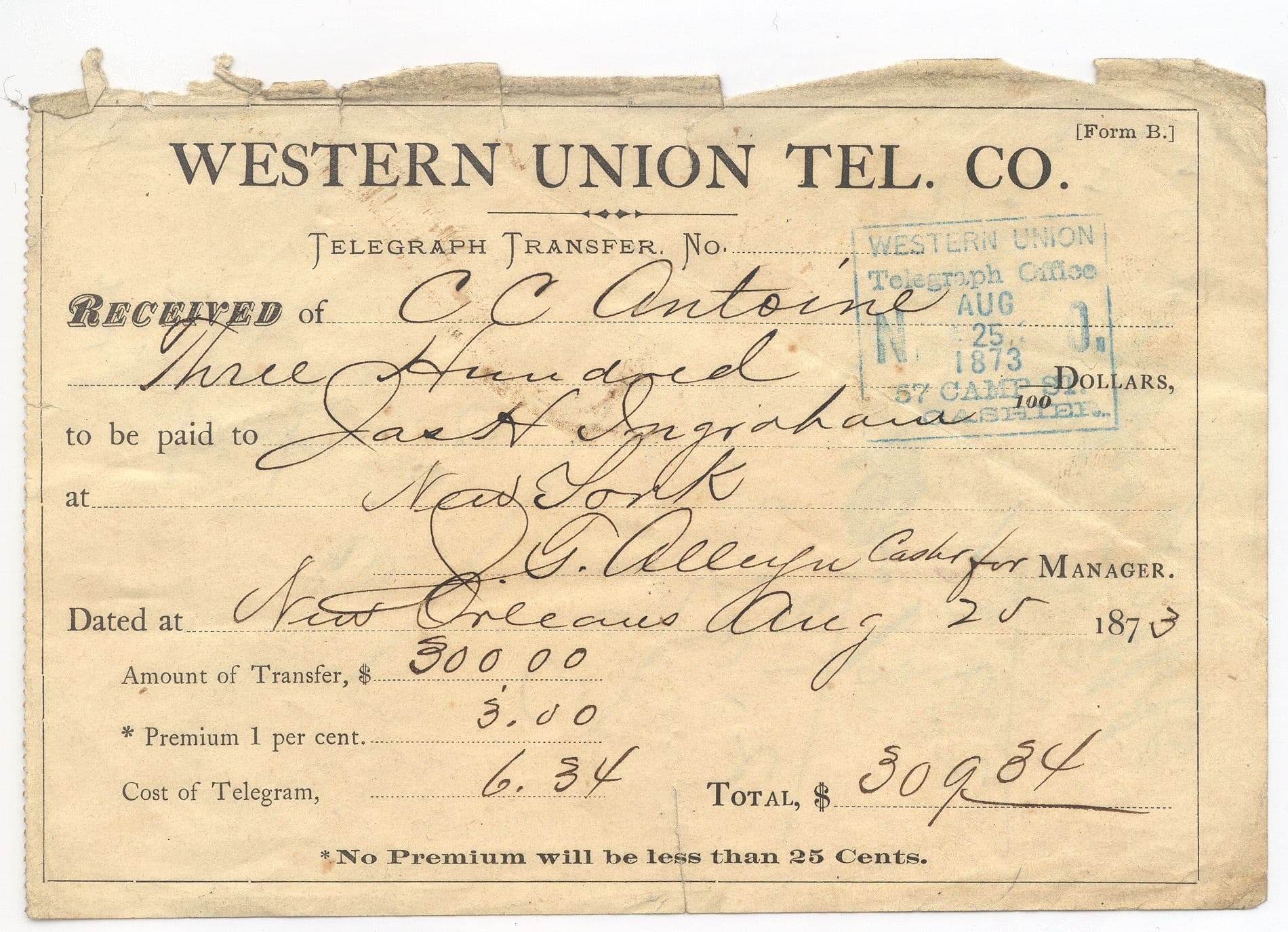Modern Treasury and Paxos Make It Easier for Businesses to Move Money with Stablecoins.Learn more →
What Are SWIFT Codes?
Originally taking place over telegraph, the means of sending wire messages have been replaced: first by the telephone network, and then it in turn by the internet. Yet the core idea of how wire transfers work has remained the same.

Though one might think them a modern invention, electronic wire transfers have existed for almost 150 years. Using its extensive telegraph network, Western Union first enabled people to transfer money electronically starting in 1871. A sender would pay money at a telegraph office, which would transmit a message to authorize the release of funds to a recipient at a second telegraph office.

Western Union telegraph wire transfer from August 25, 1873. The $300 amount is equivalent to over $6,400 today.
Wire transfers did not directly involve the physical movement of money itself—you cannot send physical money over telegraph after all—but it did involve sending a message over telegraph directing where some amount of money should go. Because both the sender and the recipient were customers of Western Union, the company could take in money in one location and then allow the withdrawal of the same amount thousands of miles away.
Originally taking place over telegraph, the means of sending wire messages have been replaced: first by the telephone network, and then it in turn by the internet. Yet the core idea of how wire transfers work has remained the same. Wire transfers are still conducted by sending messages between banks, and wire transfers remain one of the main ways to transfer money both within the US and internationally. Keep in mind that wires are credit only.
To make sure the messages get to the correct receiving bank, the messages need to be routed correctly. For domestic US wires, a routing number is used. For international wires, we use SWIFT codes.
What are SWIFT codes?
In order to solve a common problem of communicating cross-border payments, 239 banks from 15 European countries came together in 1973 to form the Society for Worldwide Interbank Financial Telecommunication. Headquartered in Brussels, Belgium, it is commonly known as SWIFT. Today, more than 11,000 institutions from 200 countries use SWIFT to communicate.
At its core, SWIFT consists of a messaging platform, a computer system to validate and route messages, and a set of message standards. SWIFT codes are a subset of the message standards. So-called SWIFT payments are not actually payments, but wire transfer information.
A SWIFT code, also known as a Bank Identifier Code (BIC), is a code used to identify the country, bank, and branch that an account is registered to. Similar to sending mail, SWIFT codes act as an address for where money should be sent. A SWIFT code consists of 8 or 11 characters, where each section of characters describe one part of a bank’s location. The codes are formatted in the “AAAABBCCDDD”, where:
- AAAA: Bank code
- BB: Country code
- CC: Location code
- DDD: (optional) branch code; Use “XXX” for the primary office
For example, a specific Silicon Valley Bank (SVB) has the 8 character SWIFT code “SVBKUS6S”. “SVBK” is the bank code. “US” is the country code (United States), “6S” is the location code. Since this is the primary SVB branch, you can append “XXX” to the end of the SWIFT code, but it’s optional.
It is crucial that the SWIFT code is correct, or your money may end up in the wrong place. With Modern Treasury, we help you validate SWIFT codes and the network of correspondent banks to use before sending international wires.
How to Find a SWIFT code
If you are wiring money internationally, there are three ways to find the correct SWIFT code:
- Ask the recipient: the person who’s expecting the money can work with their bank to determine the correct bank, country, location, and branch codes.
- Search the beneficiary bank’s (the recipient’s bank) website: if you are receiving a wire, many banks list their SWIFT codes and wire instructions on their website. For example, here is SVB’s incoming wire routing page.
- Search SWIFT’s official database: entering any or all of the name, city, and country information should return a list of possible institutions and their BIC.
How an International Wire Transfer with SWIFT codes works
To send an international wire, the sender would go to their bank and provide information about the wire transfer amount and the beneficiary’s information. The latter typically includes a SWIFT code (remember to make sure the SWIFT code is correct), the beneficiary’s name, remittance information, account number, account type, and beneficiary bank address.
The sender’s bank would take the information and send a message via the SWIFT messaging system, which would be routed to the receiving bank using the SWIFT code. The beneficiary bank would receive the message, and after performing some security checks for fraud and money laundering, credit the beneficiary with the appropriate amount.
The actual settlement of money exchanged between the sender’s bank and the beneficiary bank happens separately. If the two banks have a direct relationship with each other, they would each have accounts at the other bank. The sending bank would credit the beneficiary bank’s account.
When the sending and beneficiary banks do not have a direct relationship, funds are settled via correspondent or intermediary banks. There can be up to three of these third party banks that facilitate the actual settlement of funds. The smaller and less internationally connected the sending and beneficiary banks are, the more banks they need to facilitate international wire settlements.
Correspondent banks are also needed when settling in different currencies. If we look at SVB’s incoming wire instruction page again, we see that depending on the currency of the wire, SVB will use a different corresponding bank. When wiring Chinese Yuan to an SVB account, SVB instructs that the wire should use Standard Chartered in Hong Kong as a correspondent bank. When wiring Euros to SVB, the instruction is to use Deutsche Bank in Frankfurt as a correspondent bank. The number of banks involved is also a factor in wire payment cost. The number of banks involved is also a factor in how fast the beneficiary is credited into their account.
International wire transfers are a huge component of money transfers across borders. SWIFT codes are a reliable and internationally standard way to direct the correct payments to the correct destinations.
Conclusion
Want more ways to manage and wire money internationally with ease? Reach out to Modern Treasury for a demo.
- Western Union Twitter








